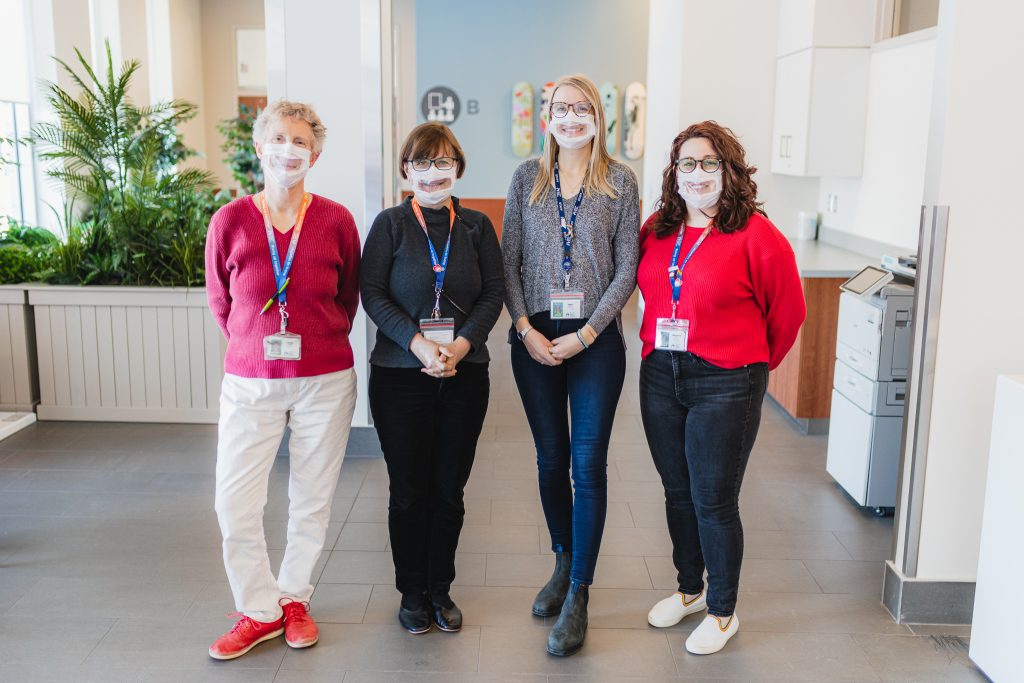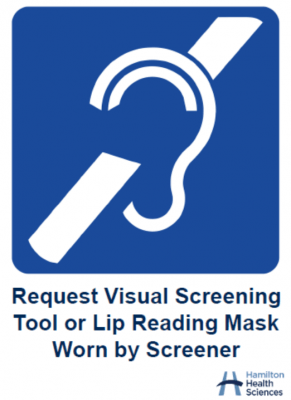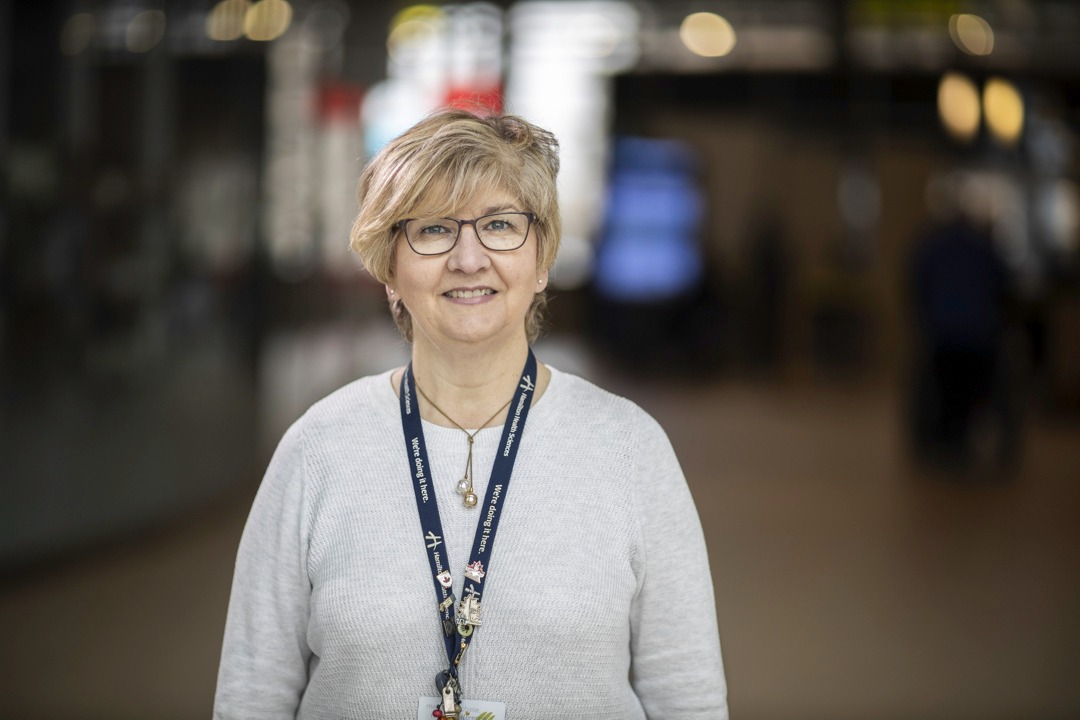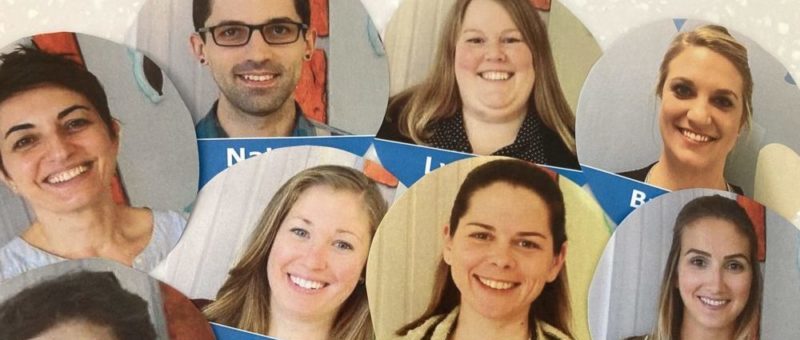
Clear masks help patients see better to hear better
When Andrea Michaluk went for an MRI at Hamilton Health Sciences’ (HHS) Hamilton General Hospital early in the pandemic, she experienced some challenges speaking with screening staff at the front entrance and staff at the clinic’s front desk.
The combination of masks, physical distancing, plexi glass, and background noise can lead to frustrating exchanges for people with hearing loss.
During the COVID-19 pandemic, Michaluk has experienced how much harder it is to navigate social interactions while everyone is wearing a mask. She has minimal hearing loss, but her brother, who is profoundly deaf, is the real driving force behind her advocacy. He relies on reading lips to communicate – an obvious challenge when people’s mouths are covered in public spaces.
Lip reading is crucial

Signage at the screening booths to let patients and caregivers know they can request the screener wear a clear mask to help with their understanding.
People rely on lip reading to “hear” more than we think.
In 2021, HHS found and purchased Canadian-made, single-use clear masks that show the wearer’s lips. These are available throughout the organization on an as-needed basis, including at the screening booths at every hospital. These booths are the very first point of contact for patients and caregivers.
The masks are also available for units to order to support patients who need them.
“HHS has been evaluating mask products throughout the pandemic, including those with a clear mouth feature,” says Jeff Mallany, safety specialist in Health, Safety and Wellness at HHS. “We heard from several internal stakeholders and community members that a solution was needed to support patients with hearing impairments and visitors generally, as well as some specific programs like audiology and speech pathology.”
Many visual cues help with hearing

Audiologist Carrie Peddle
In June 2021, audiologist Carrie Peddle began using the mask with clients at Ron Joyce Children’s Health Centre. She saw huge improvements in one patient with profound hearing loss when she switched to the clear mask mid-appointment. Even though the patient was wearing hearing aids, his access to all of the auditory information a person can get from verbal speech was limited.
“While I was discussing options with the patient and his mother, she noted that he was probably having some difficulty understanding what I was saying with the conventional mask,” says Peddle. “When I switched to the clear mask, it provided him with significantly more visual information and allowed him to participate more fully and easily in the conversation. His ability to follow what I was saying improved substantially.”
People with milder hearing losses have been able to function in the quiet environment of the audiology test booths with the standard masks, but patients with more severe hearing loss who need extra visual support to understand verbal speech require staff to use the clear masks.
The masks have also been critical when caring for patients in the speech-language pathology clinic.
Children with articulation issues need to both hear and see sounds properly to mimic them. Seeing ‘ma-ma’ mouthed, for example, helps children practice saying the word themselves. In these cases, therapists who model mouth positions for speech therapy wear clear masks too.
“Visual cues are a very effective complement to help in understanding spoken speech with more severe hearing loss in all situations, and for individuals with milder hearing loss, in adverse listening situations such as noisy environments,” says Peddle. “Hearing loss is complex and, even with well-fit hearing aids, some patients need access to additional visual cues to ease the cognitive load of communication.”
Advocating for better communication methods

Patient and advocate Andrea Michaluk (Photo credit: Martin Shoesmith)
When Michaluk returned home from her hospital visit, she wrote a letter to HHS’ Patient Experience department, who receives feedback, compliments, and complaints, to suggest some solutions to the communication barriers at the hospital. One of those solutions was the use of clear masks, which pushed the already-in-progress project forward more rapidly.
“During the pandemic there was a growing awareness of people who were deaf and how the masks were creating these communication barriers for them,” she says. “Then there was this dialogue around sign language which is definitely helpful, but there is a whole segment of the deaf community who don’t sign. Lip reading is their sole method of communicating. It was kind of a disaster for them.”
Michaluk’s brother has been lip reading for over 40 years. “To have that taken away was really tough to watch for our family,” she says. “As his sister, there is a compulsion in me to advocate for him.”
She has been an advocate for those with hearing loss throughout the pandemic.
In addition to masks, she says having photos and illustrations are helpful to provide instruction, as well as whiteboards available for two-way dialogue.
A “terrific” step forward

VP Corporate Services Kelly Campbell
“Hamilton Health Sciences is committed to accessibility and removing barriers for people with disabilities,” says Kelly Campbell, vice president of corporate services and capital development, and executive sponsor of HHS’ Accessibility Committee. “While we have many more improvements to make, we will do our best to support people in accessing our services as we continue to learn and grow.”
Facial expressions and other visual cues are also important to verbal communication.
“We’ve noticed how much we rely on facial expressions over the past year,” says Michaluk.
She says, since we can’t see people’s smiles, kind words are even more important.
“Some people can hear the words, ‘have a great day,’ behind the mask, but others aren’t even getting those little daily exchanges.”
People visiting HHS who require a clear mask for themselves or their care team can request one by contacting their clinic in advance.
“The fact that HHS has made this step is terrific.”



